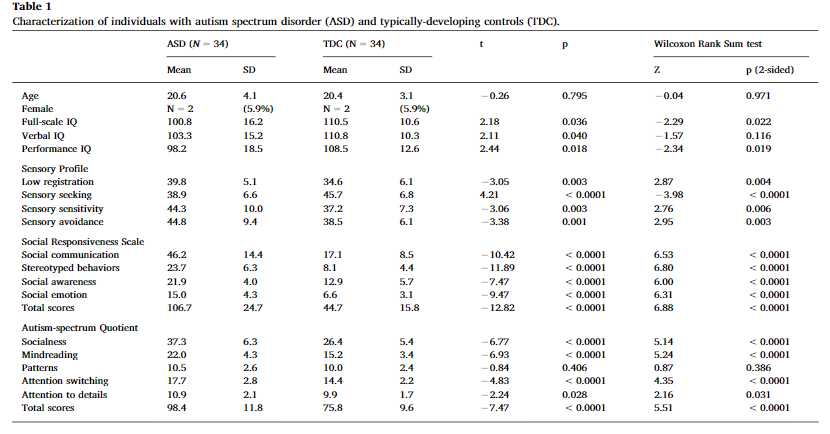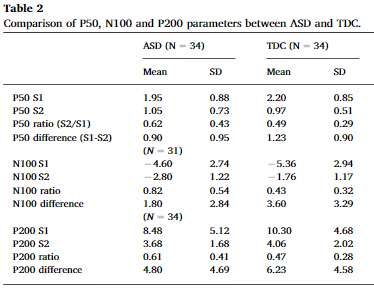Sensory Gating
Emily Herman and Rachel Chang
<<<<<<< HEAD2019-11-06 21:32:24
=======2019-11-07 09:06:03
>>>>>>> 3d2926dbfc758e5506503989fb153426f89151ceWhat is sensory gating?
P50 - suppresses auditory stimuli after 50 ms
N100 - triggers attention to stimuli
P200 - allocates attention to auditory stimuli
Note: “P” refers to a positive-going voltage peak; “N” refers to a negative-going peak. The number refers to the milliseconds following a stimulus when the given ERP component reaches its peak.
>>>>>>> 3d2926dbfc758e5506503989fb153426f89151cePurpose
Do adolescents and young adults with ASD have sensory gating deficits?
<<<<<<< HEAD =======Discussion of:
Chien, Y.-L., Hsieh, M. H., & Gau, S. S.-F. (2019). P50-N100-P200 sensory gating deficits in adolescents and young adults with autism spectrum disorders. Progress in Neuro-psychopharmacology & Biological Psychiatry, 95, 109683. Retrieved from http://dx.doi.org/10.1016/j.pnpbp.2019.109683
>>>>>>> 3d2926dbfc758e5506503989fb153426f89151ceParticipants
 >>>>>>> 3d2926dbfc758e5506503989fb153426f89151ce
>>>>>>> 3d2926dbfc758e5506503989fb153426f89151ce
Participant results
Results
 >>>>>>> 3d2926dbfc758e5506503989fb153426f89151ce
>>>>>>> 3d2926dbfc758e5506503989fb153426f89151ce
Comparison of P50, N100, and P200 parameters
There are no group correlates between P50 and P200 sensory gating.
N100 Gating Deficits in participants with ASD
<<<<<<< HEADEEG Sensory Gating

Discussion
Independent of ASD diagnosis, N100 gating deficits were strongly correlated with sensory sensitivity. N100 sensory gates were the best indicator of an ASD diagnosis.
P200 gating was correlated with attention switching difficulty in ASD participants, even though there was no difference in the gating itself between the two groups.
Lack of P50 suppression had negative associations with social deficits in ASD, though the difference between the two groups was not significant enough to differentiate between the TDC and ASD groups.